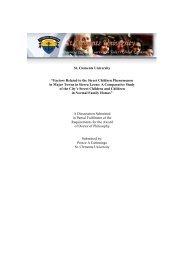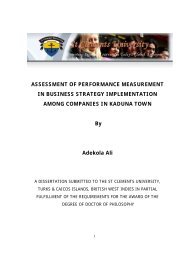Rufus Folorunso Akinyooye - St Clements University
Rufus Folorunso Akinyooye - St Clements University
Rufus Folorunso Akinyooye - St Clements University
You also want an ePaper? Increase the reach of your titles
YUMPU automatically turns print PDFs into web optimized ePapers that Google loves.
ancient China, it should not be surprising that government paper money began there as well.<br />
He said it emerged when the government had to find an alternative to the physical<br />
transportation of gold collected in taxes from the provinces to the capital Beijing. As a result, in<br />
the mid-eighth century, provincial governments began to set up offices in the Capital selling<br />
paper drafts, which could be collected in gold in the provincial capitals. He said in 811-812, the<br />
central government outlawed the private firms involved in this business and established its<br />
own system of drafts on provincial government called “flying money”. According to Rothbard<br />
the first government paper money in the Western world was issued in the British American<br />
province of Massachusetts in 1690. The province, he said, was accustomed to engaging in<br />
periodic plunder expeditions against the then more prosperous French Quebec. The successful<br />
plunderers would then return to Boston and sell their loot. They were however beaten back<br />
early in 1690 and the soldiers returned to Boston, the provincial capital, empty handed and in<br />
dire need of their pay. To avoid the catastrophe that could follow should the disgruntled<br />
soldiers become unruly, the Massachusetts government tried unsuccessfully to borrow about<br />
four thousand pounds sterling from Boston merchants because of its unfavourable credit rating<br />
at that time.<br />
It therefore decided in December 1690 to print seven thousand pounds in paper notes, and use<br />
them to pay the soldiers with a two-fold pledge that it would redeem the notes in gold or silver<br />
out of tax revenues in a few years, and that absolutely no further paper notes will be issued.<br />
More paper notes were to be issued by the government later and even those given to the<br />
soldiers continued unredeemed for nearly forty years.<br />
Cribb (1999) further disclosed that the origin of the word “dollar” might have come from a<br />
corruption of the word “thalers” which is a shortening of Joachimshtalers. He said during the<br />
15 th century, the discovery of large silver mines in Joachimsthal in Bohemia (modern day<br />
Austria) led to the issue of new, large, silver coins called Joachimshtalers. The silver from this<br />
mine was reportedly exported throughout Europe as “Thalers” in various denominations as<br />
coins soon to be “dollars” in the U.S. According to Cribb (1999) the Swedish <strong>St</strong>ockholm Bank<br />
began to issue Europe’s first printed paper money in 1661 following a shortage of silver coins.<br />
They were issued in “thalers” of various denominations.<br />
As already mentioned above the gentry and the aristocracy of London had found haven for<br />
their gold wealth in the vaults of the London goldsmiths who gave them receipts to pay<br />
creditors and they were to become the forerunner of modern day cheques. The paper money<br />
idea soon spread to Japan where feudal clans and temples acting as banks began issuing notes<br />
in the 17 th Century. At about the same time printed paper money began to be issued in the<br />
United Kingdom. A Scotsman John Law introduced the paper money idea to France and in<br />
1718 the bank that he had set up in Paris received the French king’s approval to issue notes<br />
valued in silver coin. A Norwegian Jorgen Thor Mohlen issued the first paper money for<br />
circulation in Norway in exchange for coins that he used to fund his businesses. Pope Paul V<br />
established Europe’s first national bank called Bank of the Holy Spirit at Rome in 1605. Its<br />
“scudi” note was first issued for circulation in 1786 during the reign of Pope Pius VI (Cribb<br />
1999).<br />
As could be seen in these beginnings, banks and individuals were the issuers of bank notes in<br />
exchange for the value of metal coins deposited by the individuals. These individuals circulate<br />
the notes for commercial transactions until a holder in due course of any of the notes decided
















